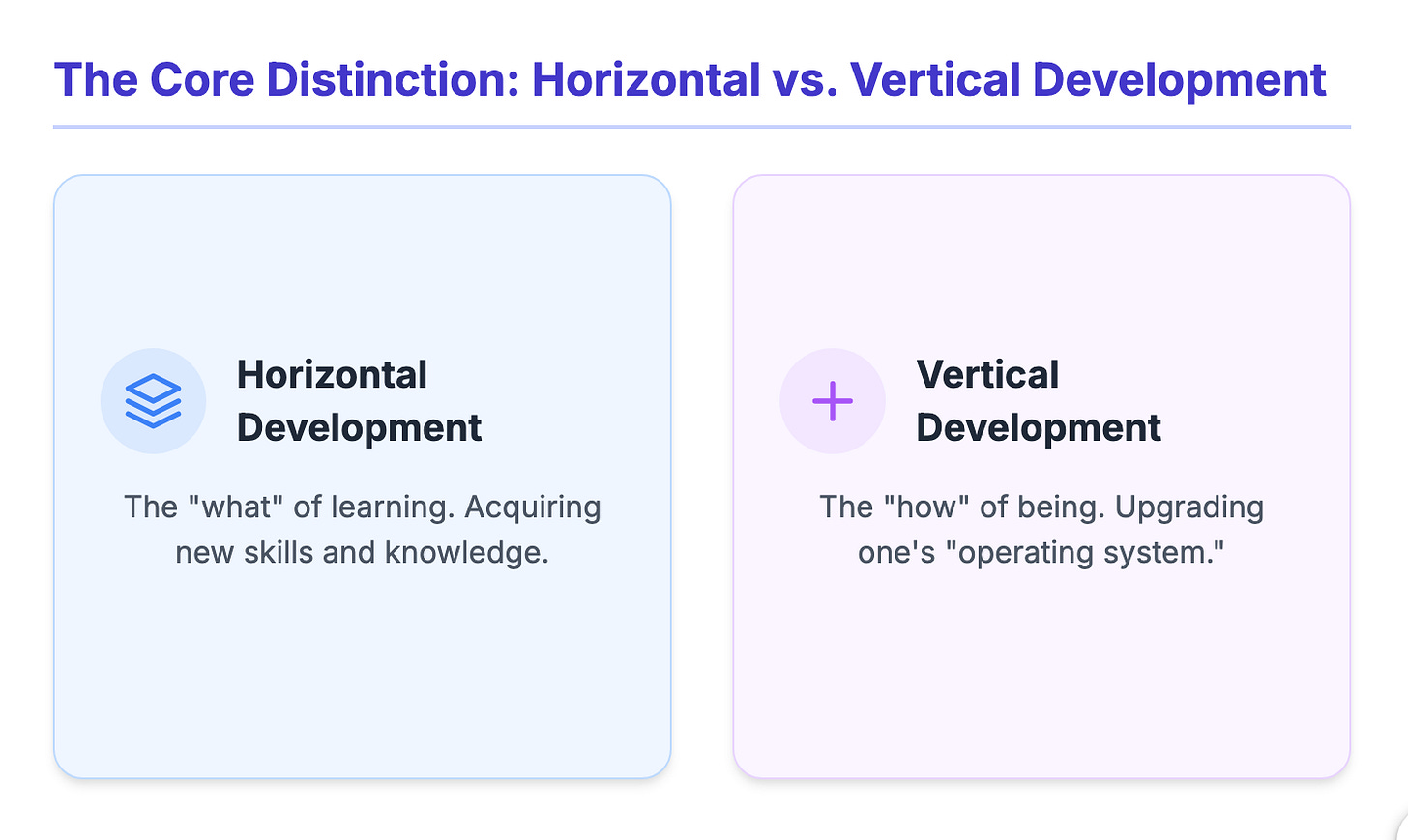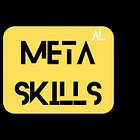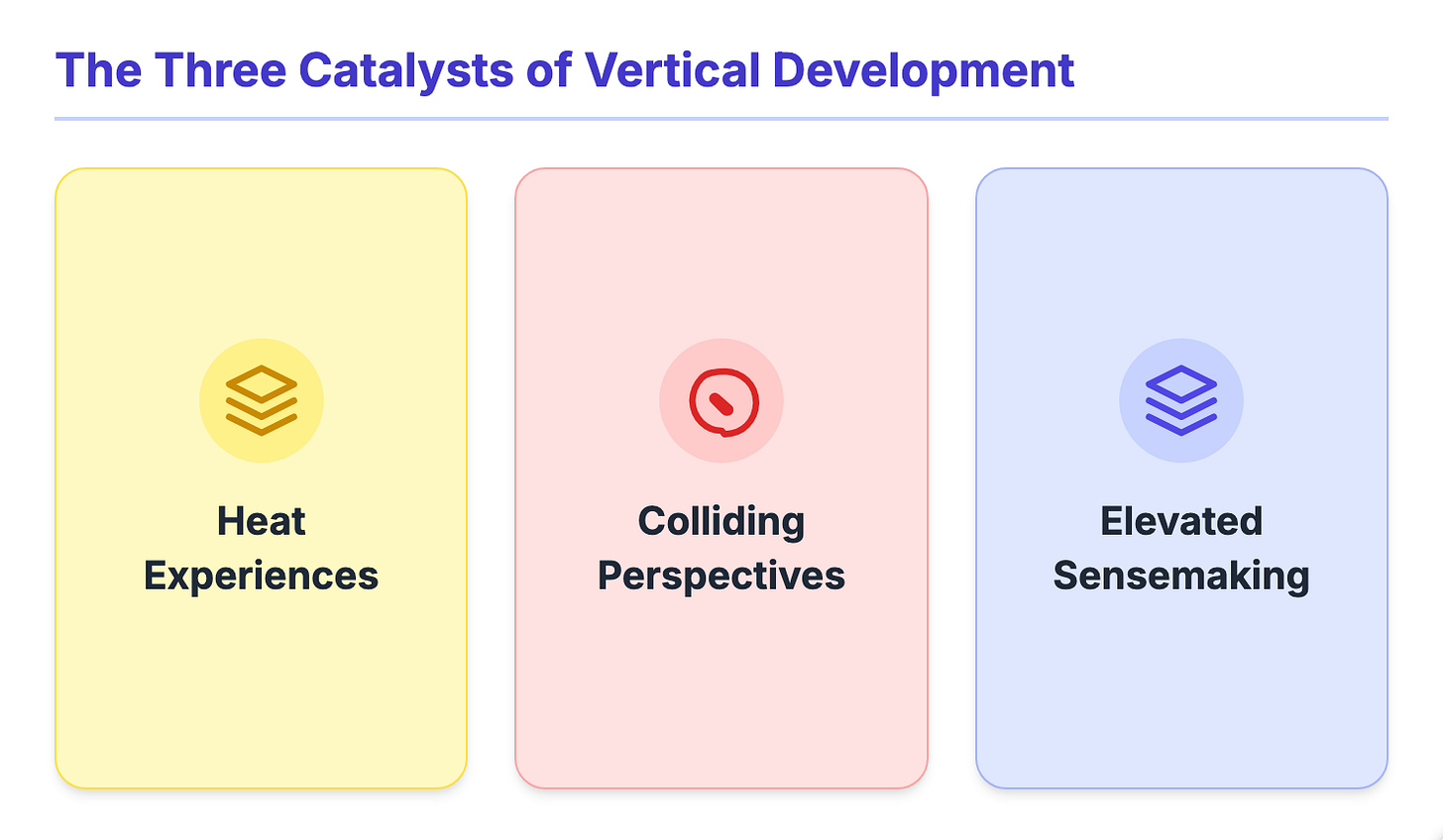The New Leadership Imperative: Vertical Development in an AI World
Vertical development explained in plain language, with examples and a simple scorecard leaders can use to boost judgment, reduce rework, and build safer, more aligned teams.
This article is a condensed and practical quick guide based on my published white paper. An interactive visual one pager is available here.
The rules of professional advancement are changing. Yes, because of AI. The traditional approach to professional development, which focuses on teaching new skills or knowledge, is no longer enough. To thrive in this new era, leaders must embrace a new paradigm: vertical development.
AI is not just a tool upgrade. It is a work upgrade. Algorithms are taking the routine load so the human work left is judgment, ethics, creativity, and coordination.
Horizontal development is about adding to what you know. Horizontal learning adds skills. Think of this as downloading apps on your phone. Skills are the apps: learning a new technical skill, mastering a software application, or getting a certification. This has long been the backbone of corporate training, but as AI becomes more sophisticated, many of these skills are becoming obsolete.
Vertical development, in contrast, is about fundamentally upgrading a human’s internal operating system. It changes how you think, how you make sense of the world, and how you lead through complexity. This isn't about learning what to do; it's about transforming who you are. This process cultivates uniquely human capacities that AI cannot replicate.
When pressure rises, most teams do not need another course. They need leaders who can hold multiple perspectives, decide under uncertainty, and create trust while things are moving.
The rise of AI is making these human skills essential for future-proofing your career. As AI handles the "grunt work" of data analysis, coding, debugging, and information synthesis, the demand for skills like empathy, ethical decision-making, and system thinking is skyrocketing. These are not skills you can pick up in a two-day workshop. They are the result of deep, internal shifts in mindset and perspective that enable you to hold paradox, navigate ambiguity, and lead with wisdom and authenticity.
For leaders, this is the core imperative of the AI age. The old "command-and-control" model is no match for the rapid, unpredictable changes AI introduces. Instead, leaders must become translators, connecting technical possibility with human reality and culture. They must foster a culture of psychological safety, allowing teams to experiment with new technologies without the fear of failure. This shift requires a both/and mindset, the capacity to be both technologically literate and deeply human-centered.
The leaders who thrive will be able to:
sit with ambiguity without freezing or forcing
balance ethics, speed, and impact without false tradeoffs
align people across functions who see the world differently
Heat experiences: Give people real stretch assignments with support. Example: a customer-ops manager owns a 90-day pilot for AI assisted triage, with a clear sponsor, a weekly learning huddle, and space to make and fix small mistakes.
Colliding perspectives: Create healthy friction by design. Example: rotate a product lead into sales reviews for one quarter, pair them with a frontline rep, and require both to write a one-page assumptions list before key decisions.
Elevated sensemaking: Run short, recurring forums where leaders examine decisions and patterns. Example: a 30-minute biweekly review that asks three questions - what changed, what we learned, what we will try next - no status updates, just learning.
Collaboration improves the moment we stop asking who is right and start asking what is true and useful now.
Here’s a simple scorecard you can use next week: Keep it stage-agnostic and business-friendly. Review monthly, not yearly.
Decision quality - clearer criteria, fewer reversals, cleaner after-action notes
Speed - time from problem to decision to first live result
Cross-functional coherence - fewer handoff issues, fewer escalations, faster alignment
Psychological safety - risks raised earlier, more ideas tested, faster course-corrections
Tip: choose one metric you can influence in 30 days. Make a tiny improvement visible. Momentum beats perfection.
Wire it into your operating rhythm:
Quarterly planning - name 2 heat experiences with a sponsor and a learning aim
Risk reviews - add one decision quality metric and one coherence metric
Change portfolio - require a short sensemaking loop for top initiatives
Talent moves - reward leaders for learning velocity, not course counts
My Point
Horizontal skills still matter. Vertical capacity multiplies their value. The future of professional development is not about choosing between human ingenuity and artificial intelligence. It's a strategic blend of the two.
Horizontal skills will always have a place, but their value is magnified by the underlying capacity of vertical development.
The call to action for every leader is clear: re-evaluate your learning strategies. Move from a mindset of transactional training to a lifelong commitment to personal transformation.
About me
I’m a leadership development consultant, certified coach, and digital transformation strategist with 18 years of experience leading people, customer operations, L&D and organizational change. I specialize in guiding leaders through complex transformations in the age of AI, with expertise in change management, leadership development, and workplace culture. As the author of Atomic Leadership on Substack, I share actionable insights that empower leaders, teams, and organizations to thrive in fast-changing environments. Follow me on LinkedIn or Connect.




